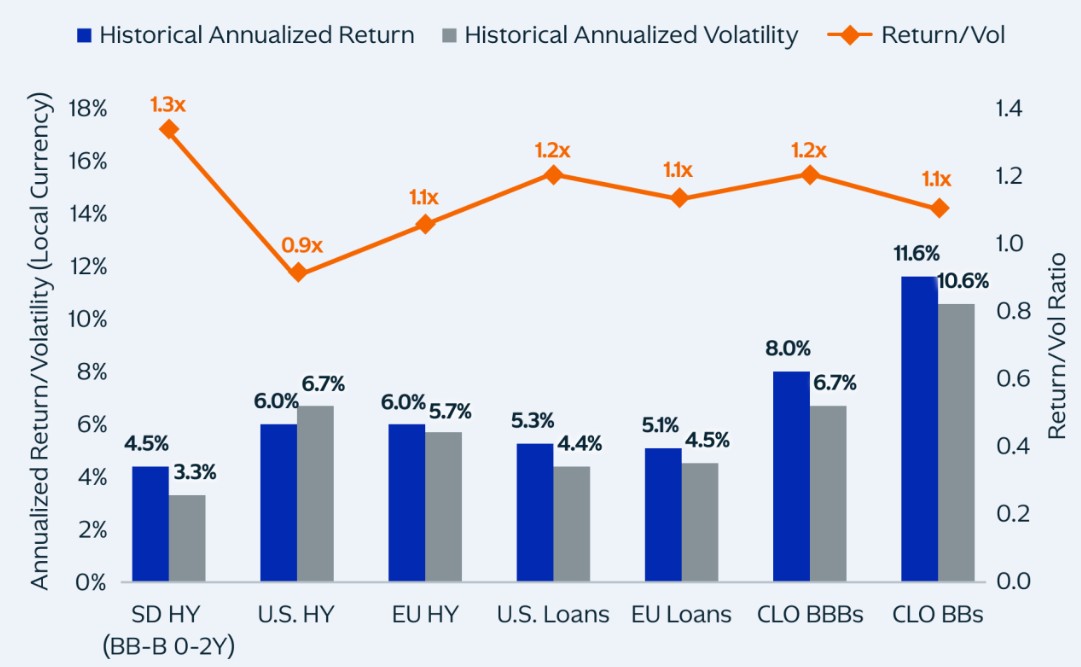Playing small ball in fixed income
Key Takeaways
- Defensive Yield with Upside: Short Duration High Yield (“SDHY”) combines attractive income with lower volatility and real downside protection, delivering steadier returns even in volatile markets. This is what we like to call playing small ball.
- Flexible Portfolio Tool: SDHY can enhance yield in cash allocations, balance duration in barbell strategies, and serve as a “cash-plus” option for uncalled capital.
- Alpha Through Active Management: The real edge comes from active management, which is when singles can become doubles, unlocking upside from calls, tenders, extensions, and market catalysts that passive, rules-based strategies can miss. With an estimated $180 billion of maturities on the horizon in the U.S. and Europe heading into 2027, this is a market where proactivity can pay dividends.
Baseball has not been a game of bats and gloves for a long time. Ever since Billy Beane took over as general manager of the Oakland A’s in 1997, the game has been transformed by advanced statistics.
Sabermetrics like WAR, OPS+ and DRS now influence and shape how teams sign players, set lineups, and make trades. The numbers can tell you a lot about who should win, but if they could truly predict the future, there wouldn’t be a multi-billion-dollar baseball industry.
A similar phenomenon is happening in today’s credit markets. In a world where investors are stuck between tight spreads, investment-grade benchmarks that lack diversification, and bouts of volatility, we believe SDHY can be a complementary or supplemental allocation in investors’ portfolios but is often overlooked.
The beauty of SDHY is that it offers exposure to the high-yield market but exhibits less interest rate sensitivity and volatility than comparable asset classes. The real secret? SDHY has delivered higher Sharpe ratios with lower drawdowns relative to the broader high yield universe while still providing meaningful income.
That got us wondering: is there a way to make our own luck? In baseball, you don’t have to hit a home run every time to win. If you know how to play the game, active management can turn base hits into doubles, or alpha, often beating what the rules-based models predict.
Baseball has sabermetrics, but the teams that win consistently use both the numbers and their instincts. The same is true in credit. SDHY is not about swinging for the fences. It is about stringing together steady returns, managing risk, and staying nimble when markets shift.
Why SDHY Works in Today’s Market
In the current environment, investors face a paradox: cash yields are finally attractive, but leaving assets uninvested can mean missing out on opportunity. At the same time, core bond benchmarks remain tethered to rate volatility and offer tighter spreads for the risk.
Short-duration high yield helps cut through this noise. It provides investors with access to the high-yield risk premium, but with less sensitivity to rate moves and a more dynamic, “resetting” risk profile.
The typical SDHY portfolio targets bonds with maturities between one and three years. This translates into lower weighted average duration, typically between 1.5 to 2.5 years, compared to 4-plus years for traditional high yield. This enables investors to sidestep a large portion of the duration volatility that comes with sharp shifts in Treasury yields.
The risk-adjusted return profile also stands out. Since 2012, SDHY strategies have delivered average annual returns of about 5%, with Sharpe ratios consistently higher than the broader high yield market.1 For example, the ICE Bank of America High Yield Constrained (0-2 Years) BB-B Index posted a return/risk ratio of approximately 1.3, compared to ~0.9 for the broader ICE Bank of America U.S. High Yield index. Maximum drawdowns have also been less severe. During the March 2020 selloff, SDHY fell about 12% peak-to-trough, while the broad high-yield index dropped 20%.
Importantly, this does not mean you need to go down the risk curve to obtain yield. Our focus has been on non-CCC, high-quality credits that are more default remote.
EXHIBIT 1: Exposure to Short Duration High Yield rated BB/B can provide stable income and historically has exhibited less volatility
Historical Annualised Return and Volatility from 2012-Q3 2025

EXHIBIT 2: Historical data indicate that SDHY (BB-B) is highly correlated with regular HY, making it a strong alternative, while exhibiting lower correlations with other credit markets

However, what really sets SDHY apart is its potential for consistent takeout activity through tenders or calls, which can drive realised returns above what the market has priced in. In these situations, the yield-to-worst (“YTW”) serves as the base case, but a corporate catalyst, such as a takeout event, may lead to higher return outcomes.
We refer to this concept as the yield to expected “take out”. In contrast, investment-grade bonds are typically redeemed at maturity. This ongoing momentum in SDHY creates recurring reinvestment opportunities, allowing managers to reset risk, harvest carry, and deploy capital at attractive entry points.
With roughly $140 billion of maturities approaching in the next 1.5 to 2.5 years, much of it among BB and B issuers, the segment is positioned for active credit selection and value capture. In practice, this helps SDHY portfolios maintain higher average yields through a cycle, capture value when spreads widen, and quickly adjust exposure if market or macro conditions deteriorate.
EXHIBIT 3: With roughly $140 billion of debt maturing by 2027, about 85% of which is rated Single B or BB, we see significant opportunities to be proactive in this market.
U.S. HY Maturity Wall ($bn)

For allocators seeking real yield and downside protection, we believe SDHY offers a rare combination: attractive income, limited duration risk, better downside protections during drawdowns, and the ability to stay nimble when uncertainty is the rule, not the exception.
Fundamentally Flexible: A Portfolio Building Block and Tool
The true power of SDHY lies in its adaptability to serve multiple roles in a modern portfolio, making it a value-add strategy for institutional allocators, insurers, and multi-asset credit investors.
- Yield Enhancement for Cash and Liquidity Buckets: For those managing significant cash reserves or short-term government bonds, SDHY can provide a meaningful uplift in yield without a dramatic increase in risk or loss of liquidity. With SDHY yields often running in the ~5.5% range, this segment has emerged as a compelling “cash-plus” alternative.
- Barbell and Duration Management: SDHY can excel as the short-duration anchor in a barbell strategy. By combining SDHY with longer-duration IG or core fixed income, investors can fine-tune their balance between yield, duration, and liquidity. SDHY generates incremental income and frequent reinvestment opportunities, while longer-dated holdings provide ballast and help manage overall interest rate sensitivity.
- Enhancing Core Plus Portfolios: In Core Plus or Agg portfolios, SDHY has the potential to add both income and agility. Its shorter maturities create a liquid “buffer,” allowing investors to rebalance or deploy capital opportunistically when market dislocations occur. Targeting BB-B short-duration high-yield exposures introduces a higher-quality profile within the high-yield spectrum, balancing downside protection with attractive risk-adjusted performance potential.
- Additional source of convexity when broader market credit spreads are tight: When spreads across the high yield and loan markets are compressed and relative value is less apparent, SDHY can provide an additional source of convexity to credit portfolios through early take-outs, tenders, and M&A activity, while maintaining downside protection.
- Support for Capital Calls and Tactical Allocations: SDHY can be a strong fit for capital waiting on private market commitments or for institutions seeking tactical “dry powder.” Allocators can keep capital in motion, earning a meaningful yield, yet retain the flexibility to pivot quickly when new opportunities arise or capital calls are made.
While SDHY can serve multiple roles in a portfolio, its ability to deliver on those objectives is shaped by the approach investors take.
EXHIBIT 4: On average, Short Duration HY has experienced a maximum drawdown of ~0.4x that of Broad HY

Achieving Outcomes Through Active Management
A key feature of SDHY is that its outcomes are often shaped by “off-model” events that static metrics or even YTW may not capture. Bonds may be called early, tendered above par, or see extension risk work in the investor’s favour. These dynamics create a wide range of potential outcomes, with realised returns frequently exceeding modelled expectations for managers who are proactive, nimble and attentive to the details, allowing them to stretch singles into doubles.
Unlike passive exposure to broad credit indices, actively managed SDHY portfolios can take advantage of the market’s complexity, particularly around call features, M&A, and the idiosyncratic nature of short-dated bonds.
A few recent cases highlight how proactive decisions can translate into tangible outcomes.
- YTW is in the eye of the beholder: In early 2025, 2028 senior notes of a North American energy producer were trading at a YTW of 7.5% at the time. Six months later, the issuer refinanced and tendered for the bonds at 101.5, well ahead of the first par call date. The trade produced a realised yield near 10.9%, demonstrating the potential for early call activity to enhance returns above initial projections.
- Corporate Catalysts: M&A activity can also generate upside. In 2024, an issuer in the building materials sector was acquired by a large retailer, which triggered a make-whole call at 103.39. Even if these bonds had been purchased at a modest premium, the acquisition catalysed a value creation event and led to a double-digit IRR, which is an outcome driven by a corporate event, not by static yield measures.
- To Call or Not to Call: Extension risk sometimes benefits the investor. When a bond trading above par is not called as expected, the portfolio continues to collect the coupon, further compounding returns over time. This is particularly powerful in higher-coupon issues, where additional carry can materially increase the realised yield.
These situations cannot always be predicted, but they are not random. They result from disciplined credit selection, close monitoring of corporate behaviour, and the ability to act decisively as circumstances change. For allocators and investors, this underscores the importance of not just which assets you own, but how you manage them, especially in segments like SDHY, where active oversight can make a measurable difference.
Batter Up
We believe short-duration high yield has carved out a distinct place in today’s fixed income landscape. For allocators seeking a combination of income, resilience, and flexibility, SDHY stands out for its ability to deliver steady returns with less sensitivity to interest rate swings and market volatility. The asset class can play multiple roles across the portfolio, providing yield enhancement, liquidity management, and a defensive counterweight to riskier exposures.
But as recent examples show, the real value of SDHY is often unlocked through active management. Navigating call schedules, credit events, and reinvestment opportunities requires judgment and agility. In this part of the market, outcomes are shaped as much by what investors do as by the environment itself.
Just as in baseball, sometimes the smartest strategy is not swinging for the fences but stringing together base hits and hustling for the extra base—steadily building your score while minimising unforced errors. And that could not be truer for credit investing.
If you are interested in more from KKR, subscribe to our latest insights here.
(VIEW LINK)2 topics

